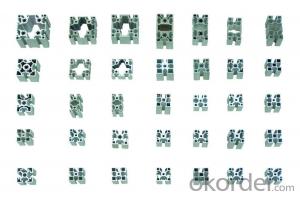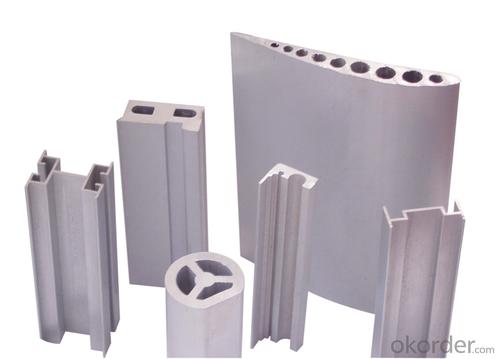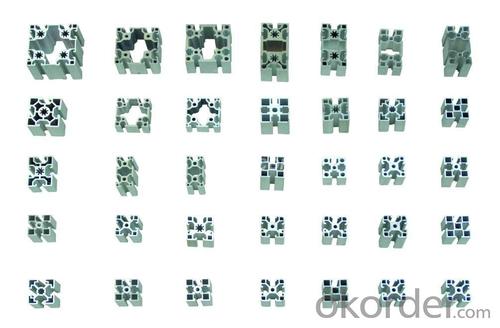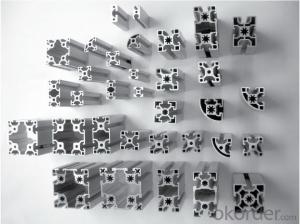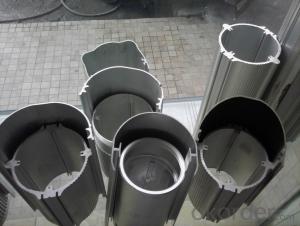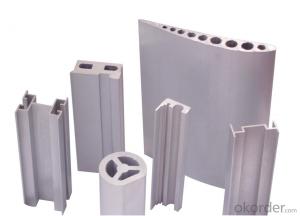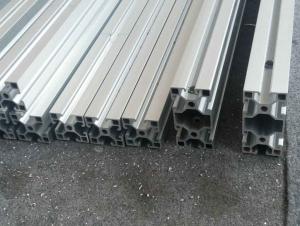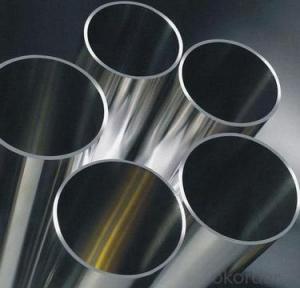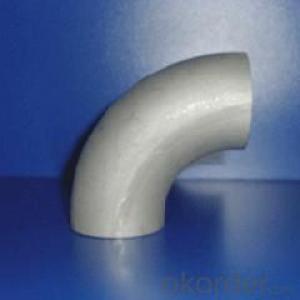Bosch Aluminum Extrusion Profiles for LED Light Strips
- Loading Port:
- China Main Port
- Payment Terms:
- TT OR LC
- Min Order Qty:
- -
- Supply Capability:
- -
OKorder Service Pledge
OKorder Financial Service
You Might Also Like
Aluminium is a relatively soft, durable, lightweight, ductileand malleablemetalwith appearance ranging from silvery to dull gray, depending on the surfaceroughness. It is nonmagnetic and does not easily ignite. A fresh film ofaluminium serves as a good reflector (approximately 92%) of visible lightand an excellent reflector (as much as 98%) of medium and far infraredradiation. The yield strength of pure aluminium is 7–11 MPa,while aluminium alloys have yield strengths ranging from200 MPa to 600 MPa. Aluminium has about one-third the densityand stiffness of steel. It is easily machined,cast, drawn and extruded.
Aluminium alloys (or aluminum alloys; see spellingdifferences) are alloysin which aluminium(Al) is the predominant metal. The typical alloying elements are copper, magnesium,manganese,silicon,tin and zinc. There are twoprincipal classifications, namely casting alloys and wrought alloys, both of which are furthersubdivided into the categories heat-treatableand non-heat-treatable. About 85% of aluminium is used for wrought products,for example rolled plate, foils and extrusions.Cast aluminium alloys yield cost-effective products due to the low meltingpoint, although they generally have lower tensile strengthsthan wrought alloys. The most important cast aluminium alloy system is Al–Si,where the high levels of silicon (4.0–13%) contribute to give good castingcharacteristics. Aluminium alloys are widely used in engineering structures andcomponents where light weight or corrosion resistance is required
Features:
Material | Alloy 6063,6061,6005or according to customer’s choice |
Temper | T3, T4, T5, T6 |
Surface | Anodize, electrophoresis, powder coating, PVDF coating, wood grain painting, matted, etc. |
Length | Coating 6.5 meters, Anodizing 6.5 meters, Mill finish 5 meters |
Application | Industrial, electrical equipment(TV set, air conditioner, refrigerator, computer), decoration,construction, transportation |
Custom Made | We can package following with customer's request. |

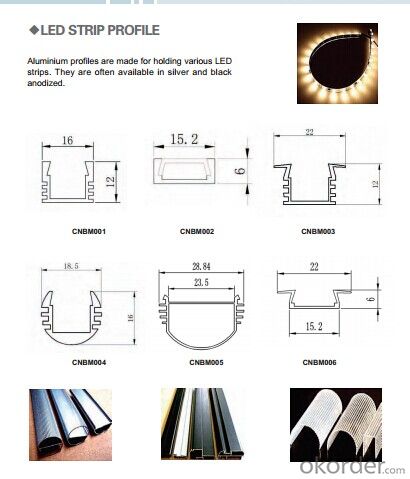
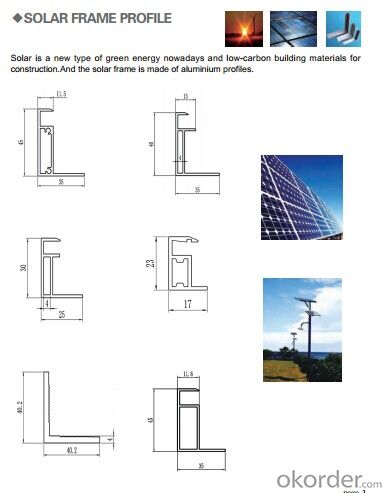
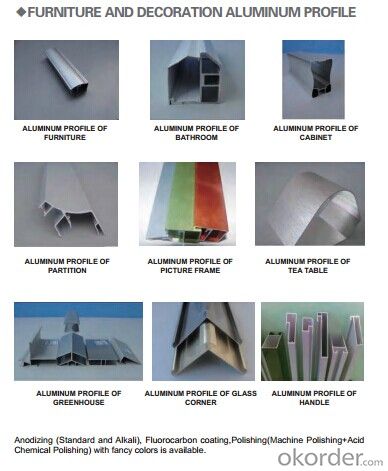
FAQ:
1. What is the form of payment?
Normally 30% TT, L/C at sight
2. Type of quotation?
FOB, CFR, CIF
3. Port of loading?
Shenzhen/Guangzhou port
4. Delivery time?
15-20 days after client’s deposit
- Q: Are aluminum profiles suitable for noise barriers?
- Yes, aluminum profiles are suitable for noise barriers. Aluminum is known for its durability, corrosion resistance, and lightweight properties, which make it an excellent material for noise barriers. Aluminum profiles can be designed to effectively reduce noise pollution by absorbing or reflecting sound waves. Additionally, aluminum's malleability allows for various design options, making it versatile for different noise barrier applications. It is also a sustainable material that is recyclable, making it an environmentally friendly choice. Overall, aluminum profiles are a suitable option for noise barriers due to their durability, effectiveness in reducing noise, and versatility in design.
- Q: Identify the key elements to evaluate when choosing aluminum profiles for a particular project.
- <p>When selecting aluminum profiles for a specific project, consider the following factors: 1) Load-bearing capacity, ensuring the profile can support the intended weight and stress; 2) Dimensional stability, to maintain structural integrity over time; 3) Corrosion resistance, especially for outdoor or humid environments; 4) Aesthetics, matching the profile's appearance with the project's design; 5) Cost-effectiveness, balancing quality with budget constraints; 6) Availability of the profile, considering lead times and supply chain reliability; 7) Ease of fabrication and assembly, which can affect construction time and labor costs; 8) Thermal properties, important for energy efficiency in buildings; 9) Compliance with industry standards and regulations; 10) Customizability, for projects with unique specifications or design requirements.</p>
- Q: How do I maintain and clean aluminum profiles?
- Achieving and upholding the cleanliness and maintenance of aluminum profiles can be accomplished by adhering to the following guidelines: 1. Consistent dusting is key: Commence by employing a gentle cloth or feather duster to eliminate loose dust or dirt. This will hinder the accumulation of grime and simplify the subsequent cleaning process. 2. Create a cleaning solution: Combine warm water with a mild detergent or dish soap in either a bucket or spray bottle. It is important to avoid the usage of harsh chemicals or abrasive cleaners, as they have the potential to cause damage to the aluminum surface. 3. Thoroughly clean the profiles: Immerse a soft cloth or sponge into the cleaning solution and delicately scrub the aluminum profiles. Particular attention should be given to areas that exhibit stains or stubborn dirt. 4. Rinse with fresh water: Subsequent to cleaning, it is crucial to thoroughly rinse the profiles with clean water to eliminate any residual soap or cleaning solution. This step is essential in preventing the formation of streaks or marks caused by dried residue. 5. Dry the profiles: Employ a soft, dry cloth or towel to meticulously wipe the aluminum profiles until they are completely dry. This will help prevent the formation of water spots and preserve the metallic shine. 6. Optional polishing: If desired, a non-abrasive aluminum polish can be applied to further enhance the shine and safeguard the surface. For optimal results, adhere to the instructions provided on the polish packaging. 7. Regular upkeep: In order to maintain the aluminum profiles in excellent condition, it is imperative to engage in regular maintenance practices. This includes consistent dusting, avoiding the usage of abrasive materials or cleaners, and promptly addressing any stains or spills. By adhering to these steps, you can effectively maintain and clean aluminum profiles, thereby ensuring that they retain their pristine appearance for extended periods of time.
- Q: This question asks for an overview of the various types of connectors that are used to join aluminum profiles in construction or assembly.
- <p>Aluminum profiles are joined together using several types of connectors, each serving specific purposes in assembly. Common types include: 1. T-slots and T-nuts, which provide a secure and adjustable connection. 2. Corner brackets, used to join profiles at right angles. 3. Angle connectors, for joining profiles at various angles. 4. End caps, used to cover the ends of profiles. 5. Clamps and brackets, for securing profiles in place. 6. Hinges, allowing for pivoting connections. 7. Cylindrical connectors, for joining round profiles. 8. Specialized connectors for specific applications, such as cable management or modular systems. These connectors are crucial for creating robust, modular structures in various industries.</p>
- Q: What are the methods to protect aluminum profiles from corrosion in environments with harsh conditions?
- <p>To prevent corrosion of aluminum profiles in harsh environments, you can apply several protective measures. First, use anodizing, a process that forms a protective oxide layer on the surface. Second, apply a protective coating such as powder coating or painting, which can provide a barrier against corrosive elements. Third, ensure proper design to prevent water trapping and facilitate drainage. Fourth, use corrosion-resistant alloys or add corrosion inhibitors to the environment. Regular inspection and maintenance are also crucial to detect and address corrosion early.</p>
- Q: This question asks for a list of different types of fasteners that are typically used in conjunction with aluminum extrusions.
- <p>Common types of fasteners used with aluminum extrusions include: 1. T-nuts and T-bolts, which provide a secure way to mount components to the extrusion. 2. Clamps and brackets, which can be used to hold items in place without drilling. 3. Corner brackets, which are used to connect two extrusions at right angles. 4. End caps, which protect the ends of the extrusion and can also serve as a mounting point. 5. Dowel pins, which are used to align and secure extrusions together. 6. Spacers, which maintain a consistent distance between extrusions. 7. Adhesives, which can be used for bonding parts to the extrusion. 8. Rivets, which provide a permanent connection between extrusions and other materials. These fasteners are chosen based on the specific application, load requirements, and design considerations.</p>
- Q: What are the specific needs or standards for utilizing aluminum profiles in cold weather conditions?
- <p>In cold climates, aluminum profiles must meet certain requirements to ensure durability and functionality. These include resistance to extreme temperatures, which may affect the material's strength and flexibility. Profiles should be made from high-quality aluminum alloys designed for low-temperature performance. Additionally, proper thermal breaks may be necessary to prevent heat loss through the profile. Corrosion resistance is also crucial, as cold environments can accelerate the process. Lastly, it's essential to consider the expansion and contraction of aluminum in cold temperatures, ensuring the design accommodates these changes to prevent warping or cracking.</p>
- Q: Can aluminum profiles be used for partitions and dividers?
- Yes, aluminum profiles can be used for partitions and dividers. Aluminum is a lightweight and durable material that can be easily shaped and customized to create partitions and dividers in various settings such as offices, homes, and commercial spaces. It offers aesthetic appeal, versatility, and can be designed to fit different sizes and shapes, making it a popular choice for creating functional and visually appealing divisions within a space.
- Q: I have a product in the aluminum above the oxidation of 20 through the hole, that is so, good heat dissipation, I do not know, right, before oxidation, punching OK?
- It is better to drill before oxidation, and then oxidize after drilling, so that the appearance will not be scratched
- Q: Are aluminum profiles suitable for balcony railings?
- Yes, aluminum profiles are suitable for balcony railings. Aluminum is a popular material choice for balcony railings due to its durability, strength, and low maintenance requirements. It is resistant to rust and corrosion, making it highly suitable for outdoor use. Additionally, aluminum profiles can be easily customized and shaped to fit any design preference or architectural style. They are lightweight, yet sturdy enough to provide the necessary support and safety for balcony railings. Aluminum railings are also available in a variety of finishes and colors, allowing for endless design possibilities. Overall, aluminum profiles are a reliable and stylish option for balcony railings.
Send your message to us
Bosch Aluminum Extrusion Profiles for LED Light Strips
- Loading Port:
- China Main Port
- Payment Terms:
- TT OR LC
- Min Order Qty:
- -
- Supply Capability:
- -
OKorder Service Pledge
OKorder Financial Service
Similar products
Hot products
Hot Searches
Related keywords

